An accommodation bill is a bill that is drawn and accepted without any consideration. These bills are drawn to assist one or both parties financially in a bill of exchange. Bills of exchange come into existence due to the same trading activities. A creditor draws a bill on their debtor for the consideration of goods sold. Bills drawn for consideration are called trade bills. The informal name for an accommodation bill is kite bill. The discounting of an accommodation bill is called kite-flying (or kiting) because the question of whether the bill will be met or dishonored on the due date is in the hands of the drawer. If the drawer provides the required amount to the drawee on the due date, then the bill is said to be honored; otherwise, the bill is said to be dishonored. Accommodation bills are not legally enforceable because they are drawn and accepted without any consideration. From a legal standpoint, accommodation bills are not bills. However, they are, in practice, treated like ordinary bills. Although there is no legal liability for accommodation bills, a strong moral understanding exists between the concerned parties. Since accommodation bills are drawn to offer financial assistance to one or both parties, an important question is how do they work. In terms of how accommodation bills function, one party draws the bill and the other party accepts it. Then, the bill is discounted by the drawer, and cash is received. The discounted amount is used by the drawer or both the drawer and drawee. Before the due date, the drawer sends the amount they used to the drawee to enable the latter to pay the bill. On the due date, the drawee honors the bill. Accounting for accommodation bills is the same process as is applied in the case of ordinary bills. i) For the Accommodation of the Drawer Only If a person is in need of money, they draw a bill on their friend and receive it discounted from the bank. The proceeds of the bill are used only by the drawer. Before the due date of the bill, the drawer sends the amount of the bill to the drawee, who honors the bill. [Accommodation Bill, Drawn for Accommodation of Drawer Only, Bill Met] A, for his own accommodation, drew on B a bill for $10,000 for three months. A had the bill discounted on the same date at 12% p.a. Before the due date, A sent the amount to B who honored the bill on the due date. Required: Pass the necessary journal entries in the books of A and B. Solution ii) For the Mutual Accommodation of the Drawer and Drawee, Bill Drawn by One Party Sometimes, two parties are in need of funds. They are not in a position to get money from any other source. To resolve the situation, one of the parties draws a bill on the other. Eventually, the bill is discounted and the proceeds are shared in an agreed proportion. The amount of discount is also shared in the same proportion. On the due date, the drawer remits their share of the proceeds to the drawee. In turn, the drawee arranges their share of the proceeds and meets the bills. [Accommodation Bill, Drawn for the Accommodation of Drawer and Drawee, Bill Met] For the mutual accommodation of S and R, S drew a three-month bill on R on 1 January 2019 for the amount of $3,000. S had the bill discounted for $2,700 and remitted 1/3 of the proceeds to R. On the due date, S remitted the amount due to R to enable him to meet the bill. Also on the due date, the bill was duly met by R. Required: Pass journal entries in the books of S and R. Solution Working 1 Working 2 iii) For the Mutual Accommodation of the Drawer and Drawee, Bill Drawn by Both Parties on Each Other This is another way of using bills by drawing bills on each other and getting them discounted from their respective bankers. The proceeds of the bills and discounting charges are shared in agreed proportion. On the due date, each party remits the required amount to the other party, enabling both to meet their bills. Accommodation bills may have the same amount and term when drawn and accepted by the parties. This makes it so that there would be no need to share proceeds and remitting the balance. Each party gets their bills discounted and pays their acceptance. [Mutual Accommodation, Bill Drawn by Both Parties, Bill Met] A, for mutual accommodation of himself and of B, draws a bill for $15,000 on B on 15 March 2019 for three months. B, on the same date and for the same purpose, draws a three-month bill on A for a similar amount. Both the bills are discounted @ 12% p.a. on the same date. On the due date, both parties honor the bills. Required: Give journal entries in the book of both the parties. WorkingAccommodation Bill: Definition
Accommodation Bill: Explanation
Kite Bill: Informal Name for Accommodation Bill
Legal Status of Accommodation Bill
Functioning of Accommodation Bill
Difference Between Trade Bill and Accommodation Bill
Trade Bill
Accommodation Bill
1. Trade bills are drawn and accepted for the same consideration
1. These bills are drawn and accepted without any consideration
2. These bills are legally enforceable
2. These bills are not legally enforceable
3. Trade bills are the acknowledgment of debt
3. Accommodation bills are not the acknowledgment of debt
4. The drawer can sue if the bill is dishonored
4. The drawer cannot sue if the bill is dishonored
5. Loss by way of discounting the bill is borne by the drawer only
5. Loss by way of discounting the bill is shared by the drawer and drawee in the ratio of their sharing in the proceeds of the bill
Accounting Treatment of Accommodation Bill: Journal Entries
Different Ways of Using an Accommodation Bill
Example
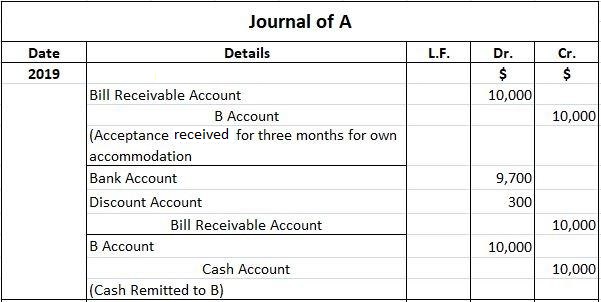
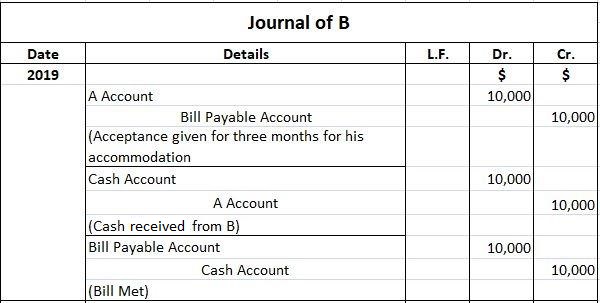

Example
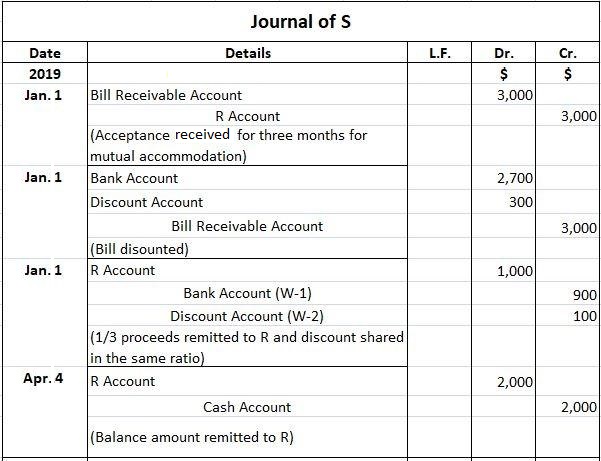


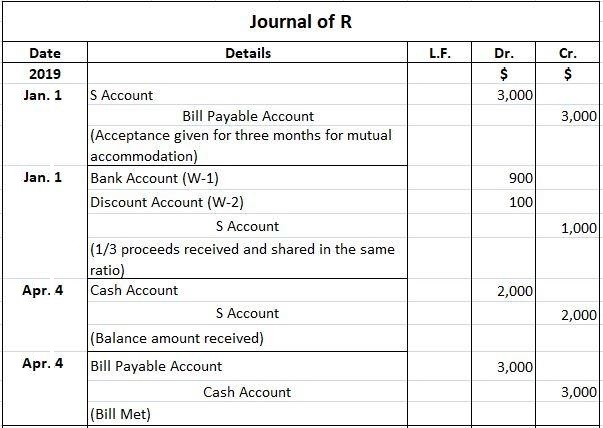
Bills of Same Amount and Term
Example
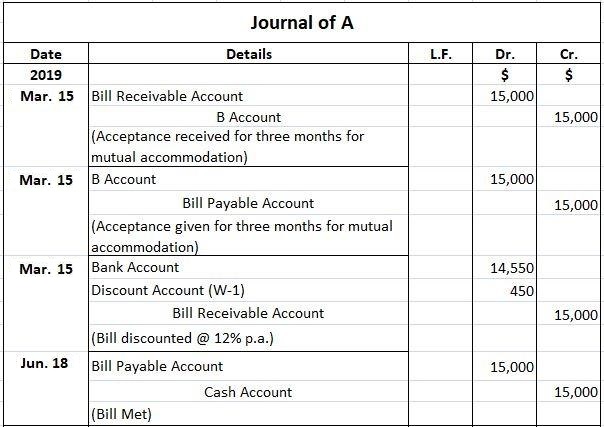
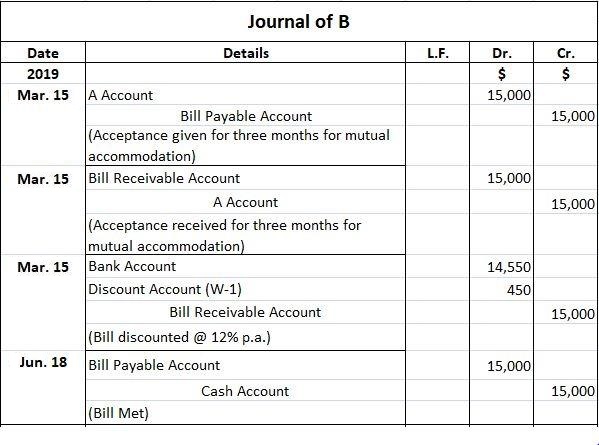

Accommodation Bill FAQs
An accommodation bill is a commercial purchase of goods which the seller treats as cash sales while actually receiving payment in some other form. An example of an accommodation bill would be where a owes money to b and b, knowing a's inability to pay, accepts a promissory note from c in full settlement of the debt.
In common law, accommodation bills are considered invalid and void because they do not represent a real transaction between the parties. In accounting, however, they are valid instruments to generate income. They should be recorded as if received from a trade sale . The sale should be recorded at the full value of the bill, and the cost of goods sold should be recorded as an expense. The journal entry to record an accommodation bill is a debit to accounts receivable and a credit to sales revenue. This type of transaction increases both assets and revenue on the company's books.
The benefit of an accommodation bill is that it allows a company to record increased sales and assets without actually having to sell any goods. This can help a company improve its financial position by appearing more profitable than it really is. It can also help a company conceal the fact that it is in financial trouble. By using accommodation bills, a company can inflate its sales revenue and increase the value of both its assets and stock price.
The main disadvantage of an accommodation bill is that it does not represent a real transaction, so it will not affect cash flow. Also, because payment is not made at the time of sale, the company does not receive immediate cash flow from the sale. This can make it difficult to pay bills and meet other financial obligations. Finally, accommodation bills can be used to inflate sales revenue and assets, which can lead to fraud and other financial wrongdoing.
Yes, some countries have passed legislation specifically prohibiting companies from using accommodation bills. In the united states, there is no specific legislation that prohibits a company from accepting an accommodation bill. However, a company that does accept an accommodation bill may be subject to lawsuits by its creditors for breach of contract or fraud.
True Tamplin is a published author, public speaker, CEO of UpDigital, and founder of Finance Strategists.
True is a Certified Educator in Personal Finance (CEPF®), author of The Handy Financial Ratios Guide, a member of the Society for Advancing Business Editing and Writing, contributes to his financial education site, Finance Strategists, and has spoken to various financial communities such as the CFA Institute, as well as university students like his Alma mater, Biola University, where he received a bachelor of science in business and data analytics.
To learn more about True, visit his personal website or view his author profiles on Amazon, Nasdaq and Forbes.











